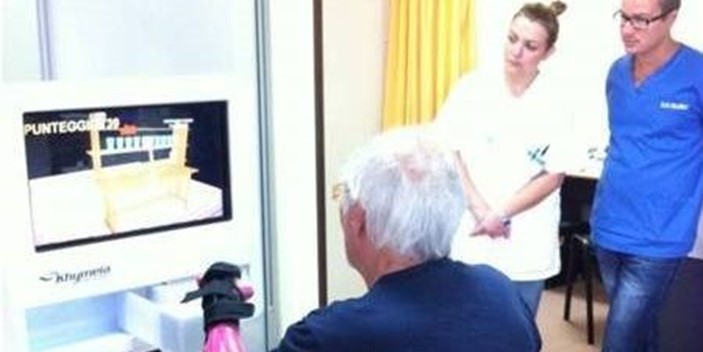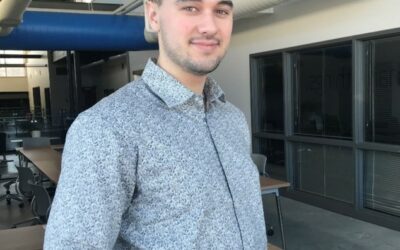Dott Rocco Salvatore Calabrò, MD, PhD
Neurologist and researcher
IRCCS Centro Neurolesi Bonino Pulejo, Italy
roccos.calabro@irccsme.it
Dr. Rocco Calabrò is neurologist and researcher at the IRCCS Centro Neurolesi Bonino Pulejo.
Would you say a few words about your background, your work place?
I am a neurologist, with a PhD in Psychiatric Sciences, and researcher. I work in Messina, Sicily, at the IRCCS Centro Neurolesi Bonino Pulejo where patients with disorders such as stroke, TBI, Parkinson Disease, Multiple Sclerosis and other neurological conditions are rehabilitated. I’m the responsible of the Robotic Rehab Service, which includes the main devices for lower (Lokomat, Ekso, Geosystem) and upper limb (Armeo, Amadeo), as well as innovative tools for cognitive rehabilitation (BTs Nirvana, VRRS).
What generated your interest in telerehabilitation (TR)?
I have been working with TR for several years. There is a strong interest for TR in Italy and we have an active national network for TR. My interest in TR was elicited by the possibility to provide seamless rehabilitation after discharge, also for people living in remote areas.
You are the PI of an ongoing project where TR is provided for people with severe acquired brain injury ABI. These are people with severe cognitive, motor and psychological impairments. What are the special challenges with TR for this patient group?
Since many of these patients are so severely impaired, they may have difficulties to initiate the TR training on their own. We are quite dependent on caregivers who can help with the setup. In general, I would say that training to use the system is crucial, not only for the patient, but also for caregivers and therapists. Everybody involved in TR has to be familiar with the TR system and to some extent convinced that this type of training is beneficial. In our ongoing study, we put a special emphasis on learning how to use the TR system. We start with TR when the patients are still at the hospital. They and their caregivers receive a thorough introduction and they can try by themselves in a separate room. We provide several sessions of TR at the hospital with a health professional who is able to assist just around the corner. By this means, we can solve most problems that can arise at home.
Could you briefly describe the study? What type of motor and what type of cognitive rehabilitation? Is VR included?
We want to include 80 patients, 40 with stroke and 40 with traumatic brain injury. They are randomized to either TR or standard rehabilitation provided by the municipality health service. The patients receive 4-5 sessions TR for 4 weeks. This includes both cognitive and motor rehabilitation according to individual needs. We assess disability, cognitive impairment, motor impairment, depression and quality of life. We expect TR to be as least as effective as standard rehabilitation.
Which system do you use for TR? Is it commercially available or custom-built or both?
We deliver the training by means of the Virtual Reality Rehabilitation System (VRRS) produced by the Italian company Khymeia (http://khymeia.com/en/products/vrrs/). Patients are equipped with tablets to do their exercises at home. These tablets are connected with a work hub, the “cockpit” where a therapist can supervise the exercises. All exercises can be adapted to the patients’ current level.
How does it work with these severely impaired patients? Is there need for support from a caretaker, what are the technical prerequisites?
Yes, we usually need the help of a caretaker to help the patients with their exercises. We have experienced that it is easier to deliver the cognitive exercises, because these are really touchscreen-based only. It can be a bit more complicated with motor exercises where the patients have to wear sensors to transfer their movements to the screen. Moreover, as most of the patients are not able to stand, balance and muscle reinforcement exercises can not be provided using TR.
TR can be delivered asynchronous and synchronous. It seems to be an advantage when a neuropsychologist or a physiotherapist is available and can help or correct the patient during the first sessions.
Regarding the caretakers, it is definitely an advantage if they have some computer experience. It makes things a lot easier. As I mentioned, we put a lot of effort in thorough training while patients are in the hospital. Therefore, not many home visits from health professionals are necessary. Most of our patients are not able to live alone. Therefore, some family member is usually around them anyway.
In your view, what are the major advantages and drawbacks of TR?
TR has many advantages. We can reach patients in rural areas and we can care provide seamless care after discharge. Furthermore, we may be able to provide rehabilitation at a higher intensity, thereby preventing functional decline. The fact that more patients can be supervised by one therapist makes it also attractive from an economical point of view.
On the background of the recent Corona pandemic, it has become obvious TR would be the only way to receive rehabilitation for many patients. However, there is still a long way to go until TR is really a part of standard rehabilitation. TR is still mainly research based and not routine care, also in Italy. That is why we could not continue the study during the Corona virus pandemic. Still, the potential for similar situations is clear. There is also potential for improvement with regard to user-friendliness, simpler systems, fewer clicks….Of course, there will always be areas of rehabilitation that are difficult to provide online. Gait and balance training for example, where there are safety concerns, or training that requires special equipment, e.g. robot-assisted gait training. Nevertheless, the is a huge potential in TR, which currently has not been realized.
(Article from the ISVR Newsletter Issue 18)




